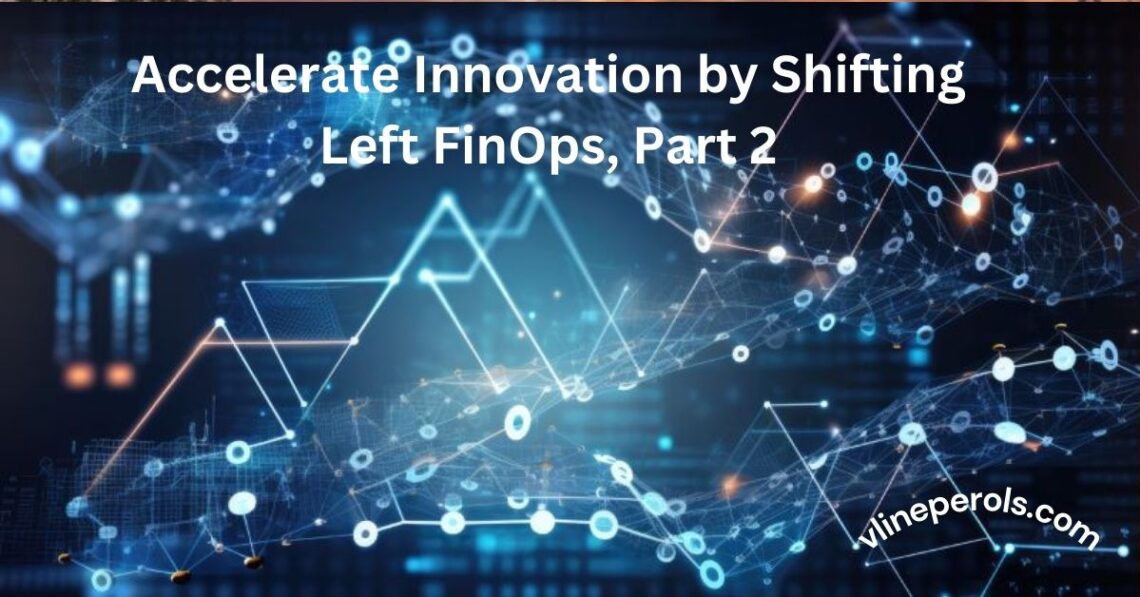
Accelerate Innovation by Shifting Left FinOps, Part 2: A Comprehensive Guide to Building a FinOps Cost Model
In the fast-evolving world of cloud computing, businesses are constantly looking for ways to innovate and optimize their operations. FinOps, short for Financial Operations, is a critical practice that helps organizations manage and optimize their cloud costs, ensuring that every dollar spent aligns with business goals. In the second part of our series on how to accelerate innovation by shifting left FinOps, we’ll explore the steps to create a FinOps cost model for an example solution.
This article will guide you through the essentials of FinOps, the importance of shifting financial operations to the left, and how to build a cost model that fuels innovation while maintaining financial discipline.
What is FinOps and Why Should You Care?
Before diving into how to accelerate innovation by shifting left FinOps, let’s quickly review what FinOps is and why it’s so important.
Understanding FinOps: The Key to Managing Cloud Costs
FinOps is the practice of managing financial operations in the cloud, combining finance, operations, and technology teams to ensure that cloud spending is optimized. The primary goal is to enable organizations to make informed decisions about cloud investments, while promoting collaboration across departments.
Cloud computing offers flexibility and scalability, but it also introduces the challenge of unpredictable and complex pricing models. Without FinOps, organizations risk overspending or underutilizing resources, leading to inefficiencies and missed opportunities for innovation.
What Does It Mean to Shift Left in FinOps?
Shifting left is a concept borrowed from software development. Traditionally, testing and quality assurance happened at the end of the software development lifecycle. Shifting left means moving these activities earlier in the process.
Similarly, in FinOps, shifting left means integrating financial operations early in the cloud adoption journey, rather than at the end. This proactive approach allows businesses to optimize cloud costs from the start and avoid financial surprises down the road.
Why Accelerating Innovation by Shifting Left FinOps Matters
Faster Decision Making
By shifting left, teams can gain real-time insights into cloud usage and costs, enabling them to make faster and more informed decisions. This accelerates innovation because teams aren’t held back by financial uncertainty.
Better Alignment Between Teams
FinOps promotes collaboration between finance, engineering, and operations teams. Shifting left ensures that everyone is on the same page early on, aligning cloud costs with business goals. This unified approach fosters innovation without the financial hangover later.
Cost Optimization at the Core
Shifting left allows organizations to address potential cost inefficiencies before they become major issues. By embedding financial management into the development process, teams can identify and correct inefficiencies in real-time, ensuring that cloud costs don’t spiral out of control.
Steps to Create a FinOps Cost Model for an Example Solution
Now that we understand the importance of shifting left in FinOps, let’s dive into how you can build a FinOps cost model for a sample cloud solution.
Step 1: Define Your Cloud Usage and Business Objectives
The first step in building a FinOps cost model is understanding your cloud usage and business objectives. It’s essential to align cloud spending with the overall business goals of the organization. This involves:
- Identifying the services you plan to use in the cloud (compute, storage, networking, etc.).
- Understanding the scalability requirements for your application or solution.
- Aligning cloud spending with key performance indicators (KPIs) like performance, availability, and user experience.
By understanding your cloud requirements early on, you can set clear financial expectations and ensure that innovation is not hindered by excessive costs.
Step 2: Establish Cost Visibility Across Teams
Cost visibility is crucial for effective FinOps management. In a typical cloud environment, costs are often spread across multiple departments, projects, and accounts. Establishing clear visibility of where cloud costs are incurred enables teams to:
- Monitor usage in real time.
- Track budgets and prevent overspending.
- Allocate costs to specific projects or teams.
Use cloud-native tools like AWS Cost Explorer, Azure Cost Management, or Google Cloud Billing to get detailed insights into your cloud costs.
Step 3: Implement a Cost Allocation Model
A critical component of a FinOps cost model is allocating costs to the appropriate teams, departments, or projects. This helps ensure accountability and transparency in cloud spending. You can use several approaches to allocate costs:
- Tagging: Add tags to resources to track and allocate costs accurately.
- Account-based allocation: Use separate cloud accounts for different teams or projects.
- Service-based allocation: Attribute costs based on the services used (compute, storage, etc.).
By implementing a cost allocation model, you’ll have a clearer view of where your resources are being consumed and can optimize accordingly.
Step 4: Set Up Budgeting and Forecasting Mechanisms
Once you’ve established cost visibility and allocation, the next step is to set up budgeting and forecasting mechanisms. It’s crucial to have a plan in place to predict future costs based on usage trends. Consider these best practices:
- Historical data analysis: Analyze past usage data to predict future costs.
- Usage forecasting: Use machine learning algorithms or cloud-native tools to predict future cloud consumption.
- Budgets and alerts: Set up budgets for each team or project and create alerts for when usage exceeds the allocated budget.
This proactive approach to budgeting ensures that costs are kept under control while innovation continues to thrive.
Step 5: Continuously Optimize Cloud Usage
Finally, to ensure long-term success with FinOps, it’s crucial to continuously optimize your cloud usage. This involves:
- Regularly reviewing and optimizing cloud resources.
- Identifying underutilized or over-provisioned resources.
- Leveraging reserved instances or spot instances for cost savings.
- Using automation to scale resources up or down based on demand.
By optimizing cloud usage continuously, you can ensure that costs remain predictable and sustainable while driving innovation.
How FinOps Accelerates Innovation
By following the steps outlined above, organizations can build a FinOps cost model that accelerates innovation. The shift-left approach ensures that financial operations are integrated early in the development process, making it easier to:
- Allocate resources efficiently.
- Drive innovation without worrying about excessive costs.
- Make real-time adjustments to improve performance and reduce costs.
In a rapidly changing business environment, the ability to innovate quickly and cost-effectively is a competitive advantage. Shifting left FinOps helps businesses achieve this by embedding financial management early in the cloud journey.
FAQs: Accelerate Innovation by Shifting Left FinOps, Part 2
What is the main benefit of shifting left in FinOps?
Shifting left in FinOps allows organizations to proactively manage cloud costs from the start, leading to faster decision-making, better collaboration across teams, and more efficient use of cloud resources. It ensures that innovation is not delayed by financial constraints.
How do I track cloud costs across different teams?
You can track cloud costs by implementing cost allocation models, using tagging, and setting up account-based or service-based allocation. Cloud-native tools like AWS Cost Explorer, Azure Cost Management, or Google Cloud Billing can help provide visibility.
What tools can help with FinOps cost management?
There are several tools available to help manage FinOps costs, including AWS Cost Explorer, Google Cloud Billing, and Azure Cost Management. Additionally, third-party tools like CloudHealth, CloudCheckr, and Spot.io can help automate cost optimization.
Why is continuous optimization important in FinOps?
Continuous optimization ensures that your cloud usage remains efficient, cost-effective, and aligned with business goals. By reviewing usage regularly and adjusting resources accordingly, you can avoid wastage and ensure that cloud costs remain manageable.
Conclusion
In part 2 of our series on accelerating innovation by shifting left FinOps, we’ve outlined the steps needed to build a FinOps cost model for an example solution. By integrating financial operations early in the cloud adoption process, businesses can optimize costs, foster collaboration, and maintain a focus on innovation. This proactive approach allows organizations to make informed decisions, enabling them to stay competitive and drive value in the cloud.
Shifting left FinOps isn’t just about controlling costs—it’s about empowering teams to innovate without financial constraints. By following the steps and best practices outlined in this article, your organization can successfully integrate FinOps into your cloud strategy and achieve sustainable, cost-effective innovation.
You May Also Like

Unveiling Phinnaeus Moder: A Glimpse into the Life of Julia Roberts’ Son
March 13, 2024
Explore Yimusanfendi – Everything You Need To Know In 2024
January 19, 2024

